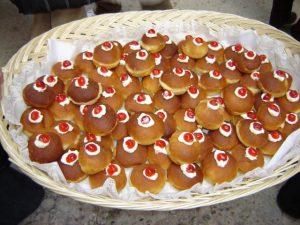Àgueda, better known in English as Agatha, is one of the saints celebrated in Majorca of whom it might be said that they are somewhat obscure, although this does rather depend on how widely (or not) they are actually celebrated. Campos, for example, would maintain that its Saint Julian isn’t in the least bit obscure; Algaida would claim likewise for Honoratus. However, there are saints who, for whatever reason, have found that they are patrons of places in Majorca, while otherwise no one seems to pay them any attention - and Àgueda is one of them.
Agatha of Sicily is in fact one of seven women commemorated by name in the canon of the Catholic mass. She therefore holds a lofty position; the Virgin Mary is another of the seven. One of the most venerated of the virgin martyrs, she met her end, it is believed, in 251, having had the misfortune to have been on the wrong end of a persecution led by the Emperor Decius.
In defence of Decius, while he was intent on persecution, Agatha might not have come on the radar had it not been for one Quintianus, a Roman prefect in Sicily. Agatha had caught his eye, and he wanted her to reject a vow of virginity and marry him. She didn’t. Quintianus was nothing if not thorough in the treatment that Agatha was to receive. This was ostensibly for being a Christian but it was more because she had turned him down. Burned with torches, whipped, stretched on the rack, her breasts cut off with pincers and finally submitted to the fire of the stake; the revenge of Quintianus was awful indeed.
Given all this, how did Agatha end up being the patron saint of Sencelles, a village known for its vines and wines and for having an August fiesta for the Assumption of the Virgin Mary which involves male and female teams hurling straw at each other?
The explanation is fairly simple, and it has to do with the timing of a meteorological event. At some time in the fifteenth century, Sencelles was enduring a drought. Sencelles was presumably not alone in this regard, and it probably wasn’t the only place in Majorca to benefit from rain that brought an end to this drought. Nevertheless, the rain came on the feast day of Agatha (Àgueda) - the fifth of February. Her patronage was thus secured.
Four years ago, Sencelles, like everywhere else in Majorca, was in a situation of drought pre-alert. At the mass for Àgueda during the fiestas, the villagers prayed for rain. As things were to turn out, there was some rain on the seventh, two days after her feast day; around 12 millimetres in areas. This wasn’t a huge amount of rain by any means, but it was still rain. Praying to Àgueda had seemingly worked, albeit that the met agency Aemet had forecast more than a week before that rain would be on its way for the second week of February. There again, the seventh was still the first week; the Àgueda effect had therefore been felt.
What appears to be missing in the story of Àgueda and her Sencelles patronage is any reference to the specific year when the rain came and brought an end to the drought. But one has to accept that there was a year; the explanation for her patronage is as good as any other which might be advanced. It also chimes with other celebrations, notably the miracle of Sant Crist (the Holy Christ), whose image brought rain to Alcudia early in the sixteenth century.
At a more contemporary level, Àgueda has become something of a symbol because of how her patronage has been applied more broadly. She is the patron of rape victims and of women suffering from breast cancer. As such, I would suggest that rather more is made of these. She is a symbol but not as much of a symbol as she might be.
It is said that her feast day comes during the period when three of the most recognised anti-carcinogenic vegetables are at their maximum fruiting - broccoli, cabbage and cauliflower. There is therefore a link with the land and with rural life, and Sencelles is somewhere that represents this. Meanwhile, the village doesn’t overlook her martyrdom and, it could be inferred, also takes account of her breast cancer patronage. The fiestas have a special cake. Known as “mamellete”, it’s an almond cake which is in the shape of a breast and has a cherry to symbolise a nipple.


No comments
To be able to write a comment, you have to be registered and logged in
Currently there are no comments.